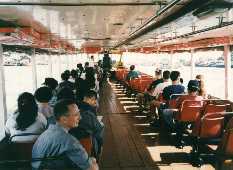
Totally roughly 6 months was spent in Malaysia (with 4.5 in Penang), 4 in Indonesia and 2 in Thailand.
I used up six rolls of film during this year: three prints and three slides (my first slides ever). The pictures on this page are all from the prints; I still havn't been able figure out how to scan the slides with acceptable results.
Click on the pictures for a larger version in a new window.
Inside one of the commuter boats on Mae Nam Chao Phraya, the main river on the west side of Bangkok.

The engines in these boats are usually from old trucks or cars, complete with accelerator, clutch and gearbox, so the boats are driven more or less like a regular bus. The man next to me did as most travelling asians do: fell instantly asleep.
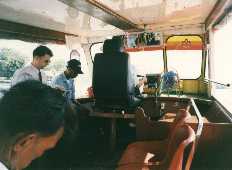
An assistant at the back directs the driver with a whistle when reversing (usually at full speed) in to the stops. There are quite some racing with the boats on the river, and among the cars and motorbikes on land as well. When the traffic isn't jammed...

Empty barges by the bank waiting for new cargo.
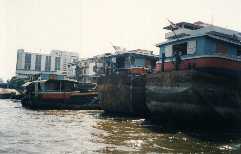
From the beach Mae Hat on Koh Phanggan island. When I arrived there in June it was totally deserted. Me and a Swiss divemaster had some 70 bungalows to choose from. Talk about Off Season... I took the hut above the restaurant, in the middle of the picture.
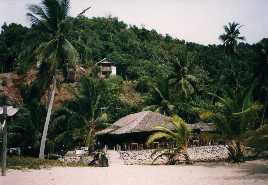
View from my hammock. Every day I went for a swim outside the reef to visit my "friend": a blue-spotted stingray. He lived under one of the rocks and were usually easy to find since his tail stuck out from the rock like a neon-blue semaphore. On the larger version (click on the pic) you can better see the canal that is used to get from the beach across the reef. Without that you'd have to walk across the sharp corals. Not funny at all. Especially in waist-deep water with waves tossing you about.
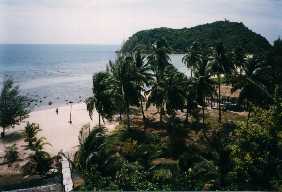
After having heard some strange sounds in the dark for some time I peeked under my hut. The jungle is almost quiet during the day, but when the dusk falls the jungle-beeps and -oumphs gets louder and louder. I found some indications of life forms also during broad daylight. When I moved in they were only a week old and hadn't yet opened their eyes.
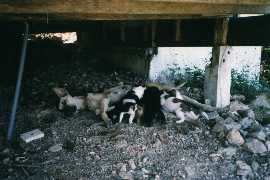
When I moved out three weeks later they could both bark, climb, and bite. I don't know what happened with them after I left, and there's a risk it's better not knowing. Their mother came from the restaurant next door but often tried to get some food from other restaurants as well. Something their dogs usually didn't like.
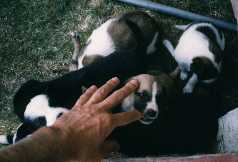
Scene from Lebuh Cintra in Georgetown, Penang, Malaysia. This particular food stall is one of my favorites and is considered to be one of best in Penang. Go there and ask for a "kueitiow chit poa", i.e "noodles one plate" in Hokkien, the chinese dialect that dominates in Penang. This plate consists of woked noodles (choose from three different kinds), shrimps, and other delicious seafood. Add some soya and white pepper. Price: less than 1 US$.
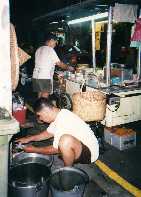
Mouse trap Malaysian style: plywood, glue and chinese cookie. Very efficient.
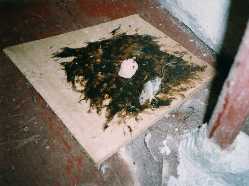
View from my "home" in Penang during the monsoon. The mixture of the old british colonial, chinese, indian, and malay give the old parts of Georgetown a very nice and special atmosphere. The Wan Hai Hotel is one of those places where long time travellers stay a while. Many go away for some weeks, months, or even years before they come back, perhaps to see some old faces, participate in the gossip, get some new info, and then leave again. After a few weeks in this dorm you're up-to-date about where the perfect beach is at the moment, where not to go, what border crossing to avoid, and other crucial info that makes life so much easier for a poor backpacker.
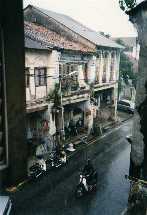
Example of long time traveller: Reggie, 74, left England in -64 and have since then had companies in Sydney and Auckland, have travelled many years in India, lived in the Australian outback, etc etc. Nowadays alternates between 3 months in Bangkok and 3 months in Penang. Is waiting for the help from the lottery to add to his meager pension. When (not "if"!) that happens he'll probably go back to northern New Zealand and live of fishing and hunting. Have also a background as flight engineer in RAF.
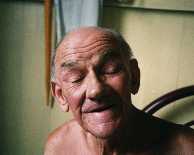
Another place to find reliable info: the reception. Loh (left) was always willing, eager & able to help with the (often contradicting) info/rumors that floats around. And another example of long time traveller: Steffen (right) travelled around the world while his girlfriend spent a year at a German research station in the Antarctic.
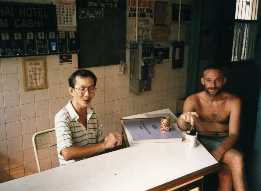
One of the speedboats that crosses the Strait of Malacca between Penang and Belawan (close to Medan) in Sumatra. There are two boats a day, six days a week, doing the 250 km trip at over 30 knots. Time is a relative thing, especially in Indonesia, and the trip usually take some 5-6 hours if everything is running smoothly. Exceptions exist. A considerably time of that can be spent standing in line, in the rolling boat, waiting to pass the Malaysian immigrations. Lots of Indonesians work (often illegally) in Malaysia where the salary can be more than twice as high, so the inspectors are suspicious and often demand time-consuming proof to let them through. If you're not alert you might well end up very far back in the queue and that do take some time (for me once: 1.5 hour... standing... crammed... hot... waves... ugh).
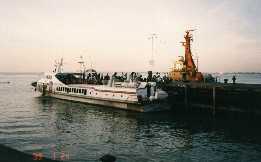
The view from Gunung Sibayak on Sumatra in Indonesia. Down at the houses to the left there are pools with hot water straight from the vulcano. An "Icelandic" feel about it. The town Berastagi in the background.
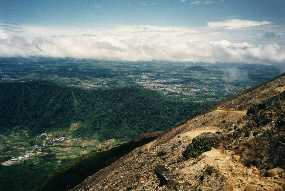
Inside Sibayak. Sibayak is a vulcano and there are lots of vulcanos in Indonesia. The tracks at the bottom are traces from a troop of young Boy Scouts that came up just before us, complete with marches, banners and uniforms. This was on a Saturday and at weekends loads of people come up from the hot and humid city of Medan to the cool and fresh Berastagi (1300 m).
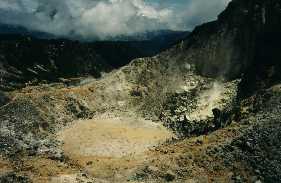
Gunung Sibayak is another vulcano only a few kilometers away. Slightly higher at 2451m compared to Sibayak's 2300m. A cloud has got stuck on the summit. Very beautiful.
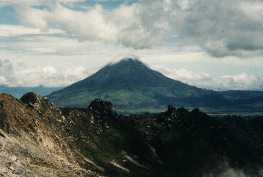
We were a fairly normal mix, we who climbed Sibayak that day. Apart from me there were Aaron (Canada), Florian and Lydia (Germany), Stanislaw (France), Rohan (Australia), and Margaret (also Australia, not in the picture).
Aaron had taken a year off from university; Flo & Lydia were on their first major trip; Stanislaw had just finished his military duty at the Frensh embassy in Colombia and had earlier made a four month trip around South-America; and Rohan was "drifting around in Indonesia" learning the language. Margaret, 44, married to a Canadian she had met in India, live in Quebec and hadn't travelled in 15 years and was now enjoying every second. She had already decided that when she come home she'll take her husband out on another trip so he also can get some new influences. 15-20 years ago she got very ill from the antimalaria pills she then was on (they are now banned) and lost all her hair. When it eventually grew back it was all white.
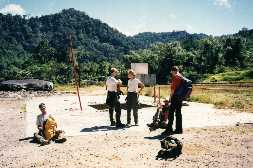
People are still living in this old longhouse. By tradition most houses are on stilts, partly to get cool from the breeze, partly to keep animals and insects at bay, and partly because of floodings that are quite common during the monsoon. Modern houses in cities are usually made of concrete and built flat on the ground.
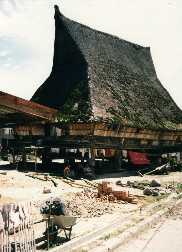
Another longhouse where the king of a small kingdom north of Lake Toba lived. His subjects didn't like that he collaborated with the Dutch and rebelled. He didn't survive and the kingdom broke up. The Bataks, who live around Lake Toba, have spent a lot of time and energy over the years fighting each other and have had a rather bloodthirsty reputation. A funny thing is that the Acehnese in the north of Sumatra did put in a lot of effort to convert the animalistic Bataks to Islam (usually with help by the sword) without success, but when Dutch missionaries later arrived they had almost no problem spreading the Christian teachings. Today are most of the Bataks Protestants.
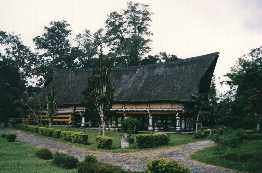
Entrance to the "castle". Note the stick used to pull yourself up the stairs.
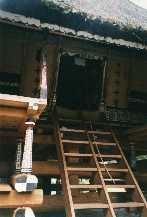
A picture from just inside the entrance. To the left are two cooking places and to the right (in the "hut") slept the king. In the big room behind the door in the middle lived several families, each with their own stove beside the beds. The floor consists of thick trees with holes between to let the cooling breeze in.
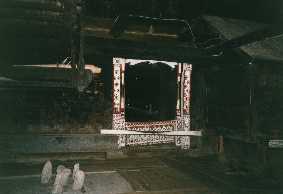
Coming down the montains to Lake Toba. The village at the lake is Tonggin where I later stayed a couple of days. There is only one guest house in Tonggin and according to them I was the first westerner in a month staying there, even though there are boats and buses to Parapat and Tuk-tuk not far away where western backpackers (and higher-class tourists) gather. Quite a few people from Medan come here during weekends though, mainly to fish in the small creeks. A perfect place to practise your Indonesian. :-)
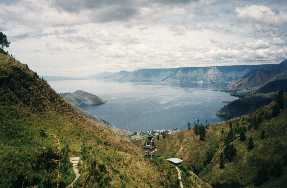
 To travel index
To travel index